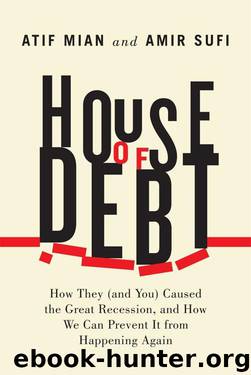House of Debt: How They (and You) Caused the Great Recession, and How We Can Prevent It from Happening Again by Atif Mian & Amir Sufi

Author:Atif Mian & Amir Sufi [Mian, Atif]
Language: eng
Format: epub, azw3
Tags: BUS000000 Business & Economics / General
ISBN: 9780226138640
Publisher: University of Chicago Press
Published: 2014-05-06T04:00:00+00:00
Saving the Banks
When the banking sector is threatened with significant losses, markets and policy makers are faced with the inevitable question of who should bear the burden. The natural solution is that the banks’ stakeholders—its shareholders and creditors—should absorb the losses. After all, they willingly financed the bank and were responsible for managing its investments. However, when it comes to banks, an alternative argument quickly comes to the forefront. Banks are special, we are told by economists, regulators, and policy makers. The government goes to extreme lengths to save the banking system, often at the expense of the common public.
The Spanish story is by no means unique. It was repeated with remarkable regularity in the rest of Europe and in the United States during the Great Recession. In 2008 the comedian Jon Stewart reacted to the bank bailout in the United States by asking a question many Americans already had: “Why not take the $700 billion and give it directly to people—why are we giving it to the banks that created this issue?”10 So why are banks so special? Why so much urgency to save them at all costs? One possible reason is political: Banks are better organized at protecting their interests. However, before we consider the political explanation, let’s review the economic rationale. This requires a basic understanding of the business of banking, which is unique in many ways.
A normal business—making furniture, for example—has a pretty simple balance sheet. The assets of a furniture business are the equipment, plants, and machines used to make furniture. A furniture company must buy these assets using money from investors. Some of the money is raised from creditors as debt (through bonds, for example). The rest comes from shareholders and is called equity. Together, the debt and shareholders’ equity make up the liabilities of the furniture company. A furniture company makes money for its shareholders by producing and selling good furniture and paying off the debt. The money left over represents profits to the shareholders.
If a furniture company performs poorly, the value of its assets declines. The equity holders of the furniture company are the first to lose. If the furniture company does very badly, eventually even the creditors must bear the losses. At that point, the furniture company goes bankrupt. A bankruptcy judge helps decide whether the company should be allowed to continue. If it is, the old shareholders are wiped out, and the impaired creditors usually get an equity stake in the firm that is worth less than the debt claims they had in the pre-bankruptcy firm. So the creditors lose out, but they were aware of the risks they were taking. There is no need for further government intervention or taxpayer bailouts. The bankruptcy process in the United States works very well for non-financial companies.
For a bank, on the other hand, its assets are not equipment or machines, but loans. When a bank makes a loan to a home owner, it is listed as an asset on its balance sheet. So the value of a bank’s assets is determined by the borrowers’ ability to make payments.
Download
House of Debt: How They (and You) Caused the Great Recession, and How We Can Prevent It from Happening Again by Atif Mian & Amir Sufi.azw3
This site does not store any files on its server. We only index and link to content provided by other sites. Please contact the content providers to delete copyright contents if any and email us, we'll remove relevant links or contents immediately.
International Integration of the Brazilian Economy by Elias C. Grivoyannis(74981)
The Radium Girls by Kate Moore(11621)
Turbulence by E. J. Noyes(7702)
Nudge - Improving Decisions about Health, Wealth, and Happiness by Thaler Sunstein(7244)
The Black Swan by Nassim Nicholas Taleb(6770)
Rich Dad Poor Dad by Robert T. Kiyosaki(6179)
Pioneering Portfolio Management by David F. Swensen(6081)
Man-made Catastrophes and Risk Information Concealment by Dmitry Chernov & Didier Sornette(5650)
Zero to One by Peter Thiel(5494)
Secrecy World by Jake Bernstein(4389)
Millionaire: The Philanderer, Gambler, and Duelist Who Invented Modern Finance by Janet Gleeson(4099)
The Age of Surveillance Capitalism by Shoshana Zuboff(3989)
Skin in the Game by Nassim Nicholas Taleb(3968)
The Money Culture by Michael Lewis(3849)
Bullshit Jobs by David Graeber(3831)
Skin in the Game: Hidden Asymmetries in Daily Life by Nassim Nicholas Taleb(3724)
The Dhandho Investor by Mohnish Pabrai(3561)
The Wisdom of Finance by Mihir Desai(3526)
Blockchain Basics by Daniel Drescher(3330)
